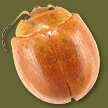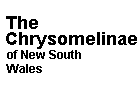

Glossary of terms used
A B C D E F G H I L M O P R S T V
Abdomen, abdominal = that part of the body posterior to thorax. The abdomen is strongly transversely segmented. The upperside, comprised of tergites, is often completely covered by the elytra but the last visible tergite, the pygidium, may protrude. The visible ventral segments are called abdominal ventrites.
Abdominal ventrites = visible ventral segments of the abdomen.
Acute = sharply angled, at less than 90 degrees.
Antenna (pl., antennae) = paired multi-segmented sense organ, arising from anterior margin of eye (Figure 1).
Anterior = at the front. Opposite of posterior.
Antero-lateral = relating to the junction of the anterior and lateral regions.
Apex (pl. apices) = the tip or end of any structure, away from the base.
Attenuate, attenuated = gradually tapering apically.
Base, basal = the nearest part of any structure to the main body. In beetles, the base of the body is at the junction of the pronotum and scutellum or elytra. Therefore the elytral base is the part nearest the pronotum and the pronotal base is the part nearest the elytra.
Bifid = forked; apically split.
Bilobed = with 2 lobes or projections.
Canthus = narrow lobe of head cutting across anterior of eye.
Claw = one of two appendages at the end of each leg; usually sickle-shaped.
Clypeal apex = the tip of the clypeus.
Clypeus, clypeal = the lower and anterior part of the head, between the frons and the anterior margin (Figure 1).
Concave = hollowed out; the interior of a sphere as opposed to the outer or convex surface.
Confused = of striae; poor demarcation by nearby punctation or sculpture.
Contiguous = adjacent or touching.
Convergent = becoming closer apically.
Convex = the outer curved surface of a segment of a sphere; opposite of concave.
Coxa (pl. coxae) = the first segment of the leg, usually transverse or globular and inserted into the body (Figure 3, Figure 5).
Cuticle = the thick outer layer of the insect body.
Disc = the middle part of any large expansive structure, for example pronotum, elytron. Excludes the margins.
Dorsal = the upper surface of any structure.
Elytron, elytral (pl. elytra) = one of a pair of modified fore-wings of beetles, characteristically rigid, which fit over the abdomen when at rest, covering the hind wings (Figure 2, Figure 6).
Elytral suture = the line of junction of the elytra, when not being used for flight (Figure 2).
Emarginate = cut-out edge or margin.
Epipleuron (pl. epipleura) = the lateral edge of the elytron bent back on itself, defined dorsally by a prominent edge (Figure 6).
Explanate = spread out and flattened.
Femur, femoral (pl. femora) = the third segment of the leg, between the trochanter and the tibia (Figure 3).
Foreleg = anterior leg (Figure 3).
Frons = portion of the head, between the eyes and the clypeus (Figure 1 - head).
Frontoclypeal suture = the line of junction of the frons and the clypeus (Figure 1).
Genus (pl., genera) = a rank in taxonomy denoting a group of species considered to be more closely related to each other than to other species.
Glabrous = hairless, without pubescence.
Head = anterior part of the body, which contains most of the sensory organs (Figure 2).
Humerus, humeral (pl. humeri) = shoulder, basal swelling of the elytron (Figure 2) covering the attachment of the wing.
Hypomeron = folded line between the prosternum and proepisternum
Impunctate = without punctures.
Lamellate = like plates, in reference to the antennal club segments.
Lateral = at the side, as distinct from anterior and posterior (Figure 2)
Margin = the area at the edge of any structure.
Mediolateral = at the middle of the sides.
Mentum = ventromedial head sclerite, distal to the labium
Mesocoxa = middle coxa; coxa of the mesothorax; basal segment of the mid leg (Figure 3, Figure 5).
Mesothorax = the second or middle thoracic segment, bearing the mid legs and elytra (Figure 5).
Mesoventrite = the median ventral sclerite of the mesothorax, formerly known as the mesosternum (Lawrence 1999). (Figure 3, Figure 4).
Metathorax = the third or posterior thoracic segment, bearing the hind legs and functional wings (Figure 5).
Metaventrite = median ventral sclerite of the metathorax, formerly known as the metasternum (Lawrence 1999). ( Figure 3, Figure 4).
Metaventrite process = anterior projection of the metaventrite between the mid legs. (Figure 3).
Mucronate = describing a process with concave sides narrowing to an acute tip.
Obtuse = shallowly angled, with apical angle greater than 90 degrees.
Posterior = behind, opposite of anterior (Figure 6)
Preapical = just before the apex.
Process = an extension of a surface, of a margin, or of an appendage.
Procoxa (pl. procoxae) = the coxae of the first pair of legs, originating from the prothorax
Prominence = an outgrowth or elevation above the surface
Pronotum, pronotal = large dorsal sclerite located between the head and the elytra, the dorsal part of the prothorax (Figure 2)
Prosternum = ventral sclerite of the prothorax (Figure 4).
Prothorax = the anterior thoracic segment, bearing the forelegs (Figure 5).
Pubescence = covering of hairs or setae.
Punctate = finely pitted, with punctures.
Puncture = a small circular pit in the surface of the cuticle.
Pygidium = the last visible dorsal segment of the abdomen, usually exposed between the apices of the elytra.
Recumbent = reclining, lying flat.
Rugose = sculptured so that the surface is irregularly raised, not smooth.
Rugulose = rugose but on a fine scale, surface appearing rough under high magnification.
Sclerite = any part of the body bounded by membranes or sutures.
Sclerotised = having a thickened, hardened cuticle.
Scutellum, scutellar = a small triangular dorsal sclerite of the mesothorax, wedged between the elytra and the pronotum. Internally, the elytra are attached to the scutellum (Figure 2).
Semicircular = literally half a circle, but here used for arcuate shapes with length more than half width.
Semiovate = arcuate in shape, with length less than half width.
Seriate = arranged or occurring in a series or in rows.
Seta (pl. setae) = a hair, an articulated hair-like projection on the cuticular surface.
Setose = covered with setae.
Sexual dimorphism = the difference in appearance between the two sexes of the same species.
Shape = the form of an object depending on its outline or extenal surface.
Sinuate = S-shaped, usually in relation to margins or edges.
Spine = a thornlike process of the cuticle, not separated from it by a joint.
Spinule, spinulose = a small spine.
Spur = an articulated spine, usually in reference to the tibiae.
Stria (pl. striae) = row of punctures, from near the base almost to the apex of the elytra.
Subapical = located near the apex.
Suture = line of fusion of two distinct sclerites.
Tarsus, tarsal (pl. tarsi) = the apical part of the leg, attached to the end of the tibia (Figure 3).
Thorax, thoracic = the middle portion of the body, between the head and abdomen, consisting of three segments (prothorax, mesothorax, metathorax) (Figure 5). The legs and wings are attached to the thorax.
Tibia (pl. tibiae) = the fourth segment of the leg, between the femur and the tarsus (Figure 3).
Trichobothrium (pl. trichobothria) = a fine sensory hair arising from a small pit at the angle of the pronotum.
Trochanter = the second segment of the leg, located between the coxa and femur (Figure 3).
Truncate = cut off squarely at the tip.
Tubercule, tuberculate = knoblike or rounded protuberance, furnished with rounded, projecting lobes
Tuft = a cluster of erect and elongate setae arising from a small area of cuticle.
Venter, ventral = the under surface of any structure (Figure 6).
Ventrite = any visible ventral sclerite, used in reference to ventral segments of the thorax and abdomen.

